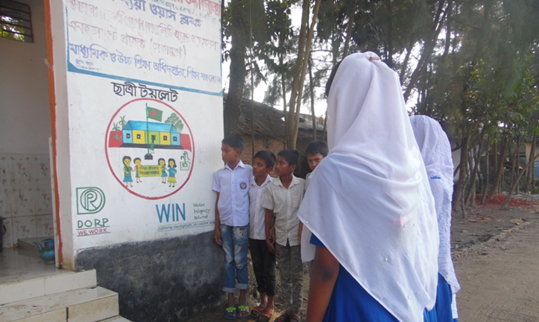Background

Bangladesh is committed to meeting the 2030 Sustainable Development Goals (SDGs), including Goal 6 on access to water and sanitation. But according to the National Hygiene Baseline Survey 2019 report, there is one toilet for every 187 students. Even where there are toilets, inadequate facilities, unhygienic conditions, and locked doors contribute to low usage. The National Hygiene Baseline Survey found that six out of every ten latrines in primary schools are actually locked, and only a quarter of them are clean. For 169 students, schools are spending Taka 61 in a month (Water Aid, 2016). As many as 73% of girls leave school earlier during the time of menstruation (RCT on School Wash, 2019).
The poor state of WASH facilities in schools cannot only be attributed to limited resources. It is also due to a lack of awareness and poor accountability and participation. Legal responsibilities and obligations are not always well understood. There is also limited transparency on funding and few or poorly functioning channels for complaints. There is a risk that money for building or maintaining toilets is siphoned off or used for other purposes because of corruption.
Since 2017, the Development Organization of the Rural Poor (DORP) and the Water Integrity Network (WIN) have been working together to understand if and how integrity issues affect WASH services in Bangladesh’s schools, using the Annotated Water Integrity Scan (AWIS) tool. The Tool was implemented in thirty schools in two hard-to-reach sub-districts (upazilas) in the Southern part of the country: Bhola Sadar of Bhola District and Ramgati of Lakshmipur District.

Project Objectives
To advocate for changes in policies and practices within government agencies (including the Department of Education) and schools to improve WASH facilities.
Key Achievements
During 2021 as per AWIS tools Follow-up in our 30 working Schools in Bhola and Ramgati, there have been identified six priority areas to bring enabling environment in School WASH:
- Quality of Sanitation Facilities
- Menstrual Hygiene Management (MHM)
- Building of additional toilets
- Gender & Inclusion
- Broader participation and awareness raising
- Budget and expenditure
By 2021, the quality of sanitation improved in almost all 30 schools. 83% of schools provided functional, improved and unlocked latrines for students. 97 new toilets have been built in these 30 schools in the last three years. There is an average of 60 students per unlocked, functional, improved latrine. Adequate hygiene kits like hand washing soap, toilet cleaning solution, toilet brush, bins have been found in 84% of toilets in 30 schools. 100% schools increased budget for WASH service in 2019, 2020 and it is continuing in 2021 as well. This is the reflection of accountability and transparency of school authority towards school WASH and its budgetary process.
29 out of 30 schools have Menstrual Hygiene Management (MHM) corner with availability of sanitary pads, soap, Hygiene kits and Sanitary pads disposal bins. All 30 working schools have separate toilets for female students with availability of water and soap and 33% of 30 schools has disabled friendly toilets. 29 out of 30 schools has proper set-up to change and dispose of sanitary napkins in schools. Gender-sensitive environment is growing up day by day in 30 working schools. This is the reflection of Transparency, Accountability, and Participation in ensuring integrity in School WASH focusing on gender inclusion.
All 30 schools have hand-washing located in the school compound. The average amount spent by schools on handwashing soap, toilet cleaning solution, toilet brush, bins etc in the preceding 30 days was Taka 1722 taka per school. 100% of schools have safe drinking water sources (32 tube wells in 30 schools) with the majority of water source catchments appearing clean and having a concrete platform to prevent contamination.
Thanks to the petition submission, schools of Bhola got Taka 811,000 and schools of Ramgati got Taka 850,000 allocation for building toilets and tube wells, sanitary napkins, masks etc. in 2021. In 2020, schools of Bhola got Taka 250,000 and Ramgati got Taka 197,250 allocation for buying sanitary napkins.
At the end of 2019, the District Education Officer of both Ramgati and Bhola issued a letter to all schools to submit a yearly total budget and allocation WASH budget for their respective schools. Following that, all schools have submitted their budget to District Education Officer. This will help to monitor the budget allocation and expenditure by the authority. This budget has been included in the schools’ budgetary book as the WASH budget in all 30 schools. This will bring transparency in schools’ budgetary process, also ensure accountability of school authority and participation of all related stakeholders.
29 out of 30 schools increased their WASH budget up to 80% in 2021 comparing 2019 and 2020.
All 30 school has ‘School WASH team’ formed in 2019 with one male and one female student from class 6 to 10. Total 10 members in the team. This will enhance the mutual accountability of both school authority as well as students to bring integrity to the school WASH service.
In 2019, school education officers and CSOs visited to practically see the WASH situation of all 30 schools. Upazila Nirbahi Officer, Upazila Chairman and Union Parishad Chairman also visited some schools’ WASH situation. This has enhanced the accountability of service providers and improved the monitoring system which made school authorities accountable to maintain an enabling WASH environment in schools.